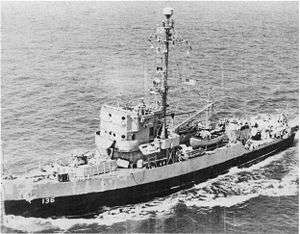Kara Sea U-boat campaign
| Kara Sea U-boat campaign | |||||||
|---|---|---|---|---|---|---|---|
| Part of the Arctic campaign of the Eastern Front of World War II | |||||||
_(6983644206).jpg) U-255 at Narvik | |||||||
| |||||||
| Belligerents | |||||||
|
|
| ||||||
| Strength | |||||||
| 6 u-boats (1943 only) | Anti-submarine warfare units | ||||||
| Casualties and losses | |||||||
| 2 u-boats sunk |
1 corvette sunk 6 minesweepers sunk 5 merchants sunk and 1 damaged 2 survey vessels sunk 1 salvage ship sunk 1 motorboat sunk | ||||||
The Kara Sea U-boat campaign was a submarine operation in the Arctic waters of the Kara Sea during World War II. Originally intended as "Operation Wunderland-II" (a follow up of an earlier raid) protracted after the official end of the operations until 1944.
Background
Operation Wunderland was a coordinated raid of the pocket battleship Admiral Scheer and u-boats in the Kara Sea occurred in 1942, resulting in a limited German success. A follow-up similar operation cod-named "Operation Wunderland-II" was planned for 1 August 1943 with involvement of the Lützow but her participation was canceled. Despite the official end of Operation Wunderland-II for 4 October 1943, operations in Kara Sea resumed the following year until 4 October 1944.[1]
Wunderland-II Operations
Since August 1943 U-255 operated near Novaya Zemlya as a refueling station for a BV 138. The BV 138 searched for Kara Sea convoys to be attacked by Lützow and the Wiking Gruppe
- On 25 July 1943, Soviet minesweeper T-904 sunk on a mine laid by U-625.[2]
- On 27 July 1943, U-255 shelled and sunk the Soviet survey ship Akademik Shokalskij.
- On 30 July 1043, U-703 sunk the Soviet minesweeper T-911.
- On 5 August 1943, the Soviet motorboat Majakovski (80tons) sunk on a mine laid by U-212.
- On 25 August 1943, the Soviet salvage ship ASO-1 Shkval sunk on a mine laid by U-625
- On 27 August 1943, U-354 damaged the Soviet merchant Petrovskij (3771 GRT).[3]
- On 28 August 1943, U-302 sunk the Soviet merchant Dikson (2920 GRT). On the same day, the Soviet submarine S-101 intercepted and sunk U-639 (the only German loss of the 1943 campaign).
- On 6 September 1943, the Soviet merchant Tbilisi (7169 GRT) with a cargo of coal, sunk on a mine laid by U-636
- On 30 September 1943, U-960 sunk the Soviet merchant Arkhangel´sk (2480 GRT) with a cargo of machinery equipment. The ship was part of the Soviet convoy VA-18
- On 1 October 1943, U-960 attacked again the convoy VA-18, sinking the minesweeper T-896. U-703 attacked the same convoy, sinking the merchant Sergej Kirov (4146 GRT) with a cargo of machinery equipment.

1944 operations
- On 12 August 1944, U-365 attacked the Soviet convoy BD-5: she sunk in succession the minesweepers T-118, T-114 and finally the merchant Marina Raskova (7540 GRT). Of 632 men from the combined ships, only 186 were saved by minesweeper T-116 and 73 by MBR-2 flying boats.
- On 26 August 1944, U-957 sunk with gunfire the Soviet survey vessel Nord. The ship could fire a single shell in defense (missed) before being sunk.
- On 5 September 1944, Soviet minesweeper T-116 sunk with depth charges U-362.
- On 23 September 1944, U-957 attacked the Soviet convoy VD-1 sinking the corvette Brilliant.[4]
- On 24 September 1944, U-739 too attacked convoy VD-1, sinking minesweeper T-120.
Outcome
The German operations in the Kara Sea had no impact on the Soviet industrial production and the Soviet shipping was only shortly disrupted. However the German operations managed to divert Soviet forces from the operations close Norway.[5]